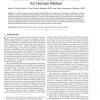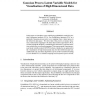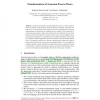98
Voted
PAMI
2008
15 years 11 days ago
2008
We introduce Gaussian process dynamical models (GPDMs) for nonlinear time series analysis, with applications to learning models of human pose and motion from high-dimensional motio...
140
Voted
NIPS
2003
15 years 1 months ago
2003
In this paper we introduce a new underlying probabilistic model for principal component analysis (PCA). Our formulation interprets PCA as a particular Gaussian process prior on a ...
NIPS
2001
15 years 1 months ago
2001
This paper presents AutoDJ: a system for automatically generating music playlists based on one or more seed songs selected by a user. AutoDJ uses Gaussian Process Regression to le...
NIPS
2004
15 years 1 months ago
2004
The equivalent kernel [1] is a way of understanding how Gaussian process regression works for large sample sizes based on a continuum limit. In this paper we show (1) how to appro...
136
Voted
NIPS
2008
15 years 1 months ago
2008
Stochastic relational models (SRMs) [15] provide a rich family of choices for learning and predicting dyadic data between two sets of entities. The models generalize matrix factor...
ICPR
2010
IEEE
15 years 4 months ago
2010
IEEE
A method for Gaussian process learning of a scalar function from a set of pair-wise order relationships is presented. Expectation propagation is used to obtain an approximation to...
DSMML
2004
Springer
15 years 5 months ago
2004
Springer
Abstract. Gaussian process prior systems generally consist of noisy measurements of samples of the putatively Gaussian process of interest, where the samples serve to constrain the...
111
click to vote
DSMML
2004
Springer
15 years 5 months ago
2004
Springer
The informative vector machine (IVM) is a practical method for Gaussian process regression and classification. The IVM produces a sparse approximation to a Gaussian process by com...
129
click to vote
HUMO
2007
Springer
15 years 6 months ago
2007
Springer
Abstract. Learned, activity-specific motion models are useful for human pose and motion estimation. Nevertheless, while the use of activityspecific models simplifies monocular t...
ICDM
2009
IEEE
15 years 7 months ago
2009
IEEE
—Triggered by a market relevant application that involves making joint predictions of pedestrian and public transit flows in urban areas, we address the question of how to utili...




